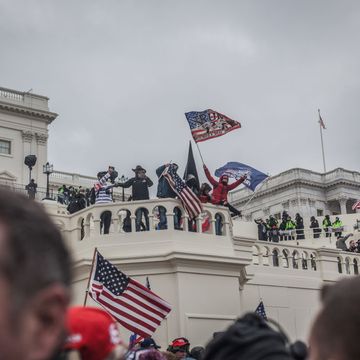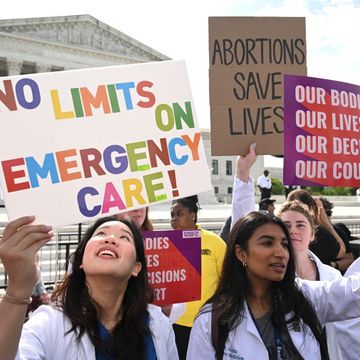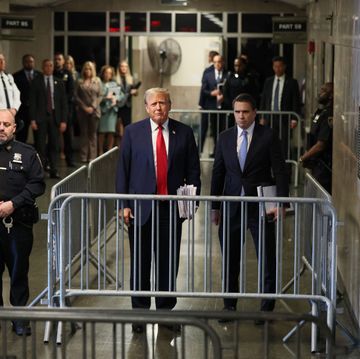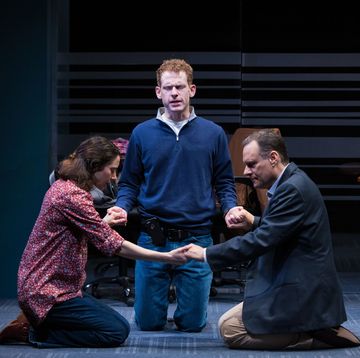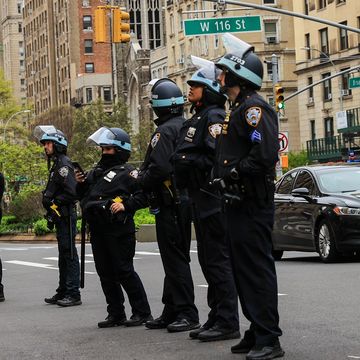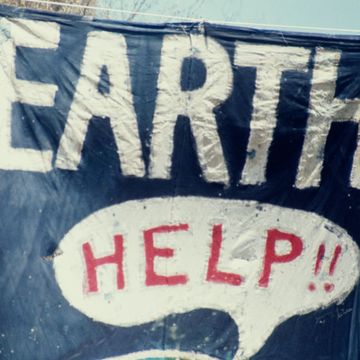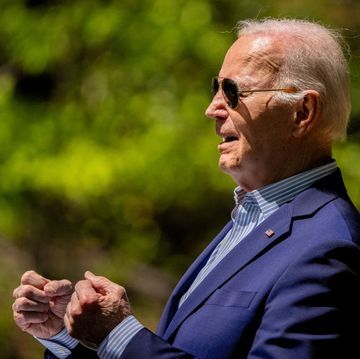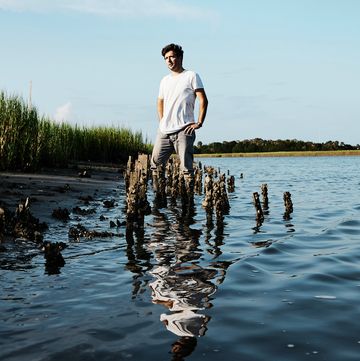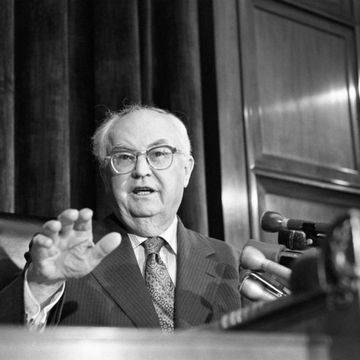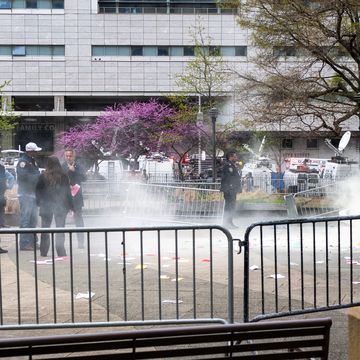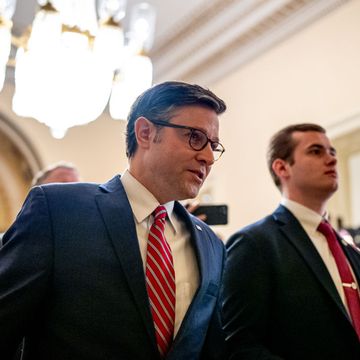Update: On April 9, 2004, in a small town west of Baghdad, insurgents attacked a U.S. Army convoy. When the smoke cleared, Staff Sgt. Matt Maupin was missing. He remained so until March 30 of this year, when his remains, discovered ten days earlier by soldiers of the 21st Infantry, were identified by DNA analysis. Maupin will now be buried in his hometown of Batavia, Ohio. But a year and a half ago, when Esquire's Brian Mockenhaupt told his story, Matt's parents still had faith that he would come home alive.
***
The boy is gone.
But where? That's the suffocating weight. When Matt was young, they would just yell out the door or walk over to the neighbors' house and grab him. Now there is nothing they can do. Keith and Carolyn Maupin wonder and worry and believe that people are out looking for him. They cast away the demons of doubt and negative thought. They imagine how he's spending his days. They tell him to stay strong, someone's coming. They thank people for their cards and prayers and the yellow ribbons they tie around their trees. They find solace in the support of so many, but they're still alone in all of this. Their boy left for Iraq and didn't come home.
So they wait. Most evenings you'll find Keith and Carolyn at their Yellow Ribbon Support Center in a strip mall near Batavia, Ohio, just outside Cincinnati. For two years, they've been shipping care packages of toiletries, candy, snacks, and stationery to service members in Iraq. Thousands of boxes. In each one are ten pictures of their son in desert fatigues, behind the wheel of an Army truck. Stickers on the backs of the photos read: I'M CAPTURED IN IRAQ, AND PRAYERS CAN SET ME FREE. They say their son knows they're doing everything they can. "And I think he would be really hurt if he thought we weren't doing anything," Keith says. "He'd give up, and we can't be having him give up." They worry that people will forget about him, forget that he's lost in Iraq. This storefront is their campaign office, the nerve center of their effort to keep him in the public eye and keep pressure on the military. "What they're doing isn't working," Keith says. "There has to be something else. It's not my job to figure out what that is. It's my job to stay on their asses until they find him. Two years is too damn long."
Pictures of Maupin cover the walls, along with posters and cards of support from across the country and from Iraq. Locals cycle through to pack boxes and drop off donations. They talk about how Maupin is a good kid, an all-American kid. How he drives that red Mustang. How he played football. How he's tall and strong with a thick, broad back. How he likes Dr. Pepper and Smarties. They say he's mischievous, kind, and a little bit shy. That he joined the Reserves to pay his own way through college. They say it's a shame what happened.
Long before Iraq, Maupin brought his parents along to meet a recruiter. Something about the sales pitch turned him off, he said no, and Carolyn and Keith, a former marine, were fine with that. But the idea came back a couple years later, and this time he visited the recruiter by himself. "I've gotta do what I've gotta do," he said when his parents asked him why. They'd always told the kids the same thing: Treat people right, get good grades, and you can go wherever you want in your life. They hadn't figured on the war. "Matt, you know, you go to Iraq, you better be willing to kill that guy," Keith said. "Because if you don't, he's going to kill you dead."
"Don't worry about me," Maupin said. "I'll be coming home." He said that to a lot of people around town before he left. Now they look at the silhouette on the black POW/MIA flag, and they see Maupin, the only soldier missing in this war.
His buddies knew early on that he was gone, after they'd done a quick head count and started cobbling their stories together. No one saw him disappear, but he wasn't with them, so they knew he was still out there. And at that moment, he wasn't the only one. In fact, if you climbed into one of those trucks that morning, you had a one-in-four chance of not making it from point A to point B. If you weren't captured or killed, you were probably wounded. Less than half arrived unbloodied. And if you weren't wounded, then you were damn lucky, because who could run through that and not get hit? So they clustered together and worked on the puzzle. They sorted through which trucks made it, which ones broke down, and which ones blew up. All they really needed to do was look west and count the black pillars shifting in the breeze. Not far away, gunfire and explosions still crackled and boomed. The fight continued on that warm spring day, with the dead trucks burning like giant funeral pyres, pumping dense smoke into the cloudless sky. That was the kill zone of the biggest, longest ambush American soldiers have faced in Iraq. That was April 9, 2004, Good Friday and the one-year anniversary of the fall of Baghdad, the day the tanks pulled down the statue of Saddam.
Keith Matthew Maupin went to war at twenty as an Army truck driver, arriving in Iraq in March 2004, a few weeks before America found out just how bad the insurgency would be. He deployed with the 724th Transportation Company, an Army Reserve unit from Bartonville, Illinois, trained to haul the supplies that feed a nation's war machine. But that task had been farmed out to KBR, an arm of the Halliburton Company, so the 724th would protect the KBR trucks as armed escorts. The unit they were replacing drove with them for several days, teaching them about the routes and possible road hazards -- an occasional roadside bomb or a few rounds of small-arms fire.
In phone calls and letters home, Maupin told his parents that Iraq sucked, that he wanted to be back in America. But he was proud to be a soldier, proud to contribute something to the war. He was always that way. On the high school football team, he didn't play as much as he'd hoped, but he never missed a practice. His enthusiasm didn't waver and he didn't complain. He didn't complain as a soldier, either, and soldiers see bitching as their birthright. Instead he was quiet and earnest and determined. Ask him to do something and he'd never tell you no. He'd just work hard and fast and get it done, something he learned early on as a twelve-year-old kid sweeping up and emptying trash cans at the AmeriStop gas station to earn his own money. He was friendly with everyone in his platoon but preferred to be on the fringe, laughing at a joke instead of telling one, and he didn't mind being alone. Every night in Iraq he lifted weights at the gym and rode his bike around camp, machine gun slung across his back. He'd been studying nutritional sciences at the University of Cincinnati, and he loved to work out, but Carolyn thinks this was something different. Maybe he could feel a bad day coming. Maybe he knew he'd need his strength.
By mid-March Maupin's unit was on its own, escorting fuel convoys all over central Iraq. The missions ran smoothly until April 6, when a convoy was ambushed in the town of Hit, west of Baghdad. Even that wasn't too bad. They killed three insurgents, all of the rocket-propelled grenades missed, and when they later surveyed the damage, they counted only two bullet holes among all the trucks. They came back from the mission pumped up from their first contact but wondering if maybe this wouldn't be as easy as they had thought. And the bits of news they heard gave more cause for worry. The Marines were pummeling Fallujah, a hasty response to the killing of four American security contractors. In Baghdad, simmering tensions with Moqtada Al-Sadr exploded, and he sent forth his giant private army to wreak havoc. The violence spread fast to outlying cities. The roads were treacherous, and supplies weren't getting through.
Maupin and the guys in his unit didn't know it, no one did, but the country was exploding. Just ask the guys from the 724th about it now. "It was fucked up from the beginning," says Specialist Dustin Row, who drove a gun truck that day. "It was all kind of rigged together. I was nervous as hell. We all were."
Second platoon, led by First Lieutenant Matt Brown, was scheduled to move fuel to Al Asad air base, northwest of Ramadi, on April 9. Six Army gun trucks and humvees would escort seventeen rigs pulling seventy-five-hundred-gallon tanker trailers of JP8, the diesel fuel used to power everything from tanks to helicopters. Two more KBR employees would drive "bobtails," rigs without trailers, to pick up stranded tankers if any of the trucks broke down. Two soldiers from another unit would tag along in an unarmed humvee to learn the route.
Late on April 8 the mission changed. U.S. forces stationed at Baghdad International Airport were calling for an emergency resupply. Lieutenant Brown heard about the change after midnight. The convoy would leave Camp Anaconda and drive south on Route Tampa to Route Irish, the notorious airport road famed for its frequent car bombings and IED attacks. The soldiers woke early the next morning to prep their trucks and weapons. Leaders of the 724th had ordered their convoys to carry double the normal load of ammunition after hearing intelligence reports that insurgent activity had picked up across Iraq. Shortly before the convoy was scheduled to leave, the route changed again. An IED had been discovered at the Route Irish entrance to the airport. The convoy was redirected to the airport's north gate. No one from the 724th had driven this route. They brought in a soldier from another unit to serve as a guide, though he'd been through the north gate only once. And with good reason, he said. The route is dangerous.
Indeed. The Army color-codes its roads: green, amber, red, and black. The 724th was told its route was amber, meaning little expectation of enemy activity. That morning the roads -- routes Sword and Cardinals -- were actually black: enemy attack imminent or ongoing. Minutes before the convoy pulled out, the highway-safety office at Camp Anaconda tried to send an e-mail to the 172nd Corps Support Group, the unit that oversaw the 724th. "Sorry," the e-mail read, "looks like Sword is closed until further notice." But the soldier who wrote the e-mail sent it to himself by mistake.
If Maupin and his buddies had talked to soldiers from the 1st Cavalry Division, which was responsible for the area they were about to drive through, they would have turned off their trucks and gone back to bed. The Abu Ghraib district, a sliver of towns north of the airport that stretches west from Baghdad to the notorious prison, had never been a safe place for U.S. soldiers. Rocket attacks, mortar fire, and IEDs were commonplace. But since April 7, the neighborhood had turned downright nasty.
Insurgents had been dumping dozens of white-phosphorous and high-explosive mortars on U.S. soldiers at an outpost just north of the airport compound, next to the north gate. They sniped at the soldiers from the massive buildings of an abandoned milk factory nearby. They stepped into the streets long enough to fire RPGs, then ducked back into the warren of alleyways in the town's market. The Americans stormed the milk factory to silence the snipers, called in artillery strikes, and fired into the market, starting a blaze that burned down the rickety vendor stalls. But the fighting spread. Abu Ghraib is mostly Sunni, and these were Sunni fighters, wearing civilian clothes with red-checkered kaffiyeh scarves wrapped around their heads. At the same time, Al-Sadr's Shiite Mahdi Army militiamen were moving into Abu Ghraib. The two groups don't share many goals or views, but in early April they found common cause in trying to kill Americans. They came in cars and minivans packed with weapons. They burst into local houses and set up fighting positions. They seeded the roadsides with bombs. By the morning of April 9, 1st Cavalry units were firing at two-man RPG teams moving into positions near Route Sword. And the rules of engagement had changed. Men wearing black clothes and green headbands and armbands -- the Mahdi Army uniform -- were fair game, armed or not.
Maupin's platoon knew none of this. As they drove away from Camp Anaconda and south toward Baghdad, Iraq looked the same as it did every other day -- parched, dusty, and vaguely hostile. But after the convoy turned west on Route Sword, northwest of Baghdad, the traffic thinned. And empty roads are dangerous roads. You're much better off sharing the streets with taxis and delivery trucks and kids riding bicycles. Then the traffic was gone. Brown watched a man sprint away from the road. A truck blown up in an earlier ambush burned on the roadside. A lone U.S. tank, parked near the highway, fired into the buildings to the south. That was odd. Someone in the tank waved at the convoy, a what-in-the-hell-are-you-doing-out-here sort of wave. Brown had the same thought. "I think we're in some trouble," he told the guys in his truck.
The machine guns opened up first. Fighters hiding in ditches and houses tore into the convoy, front, back, and middle. Then came the rockets and mortars and bombs.
Chunks of cement and debris and tires littered the highway. The garbage bags beside the road were too evenly spaced, a perfect daisy chain of IEDs. This was well planned. Up ahead a truck burned near an overpass, partially blocking the road. "Go right!" Brown shouted to his driver, Private First Class Jeremy Church. "Now!" Church swung the humvee across a patch of dirt onto an access road running parallel to the highway. Some trucks followed, others stayed on the main road. The convoy was falling apart. But keeping sense of the whole was futile. Everyone was caught up in his own struggle.
Brown found a target, flicked off the safety on his rifle, and started to squeeze. A gunman beat him to it and a bullet drilled a hole through his windshield. Brown's head snapped, his helmet flew into the backseat, and bullet fragments split his forehead and shredded his left eye. Church, driving with his left hand while firing out his window, felt glass spray across the right side of his face. He turned to look at Brown, who put his hand to his face and felt something between his palm and his cheek. That was his eye. His fingers slid inside his scalp. He tried to talk but the words weren't coming. He looked around the truck. Everyone else was alive and fighting.
An IED thundered beside the truck, blowing out the left front tire.
Church dug out a field dressing and told Brown to cover the wound. Brown doesn't remember saying anything before passing out, but he did, looking at Church through his one good eye: "We need to get the fuck out of here."
The radio barked with urgent voices, calls for help. "You gotta keep pushing through!" Church yelled. "You can't stop!"
Stopping wasn't intentional. That just happened. That's what bullets do to engines. Drivers mashed the gas, but the trucks slowed and their cargo burned, throwing a wall of black smoke across the highway.
Specialist Dustin Row, in the eighth truck, drove into the darkness and aimed his truck for the patch of light on the other side. The curtain of smoke parted and a rocket sang in from the right, punching through the tanker in front of him. Fuel splashed onto his truck, like someone had done a cannonball into a pool. Row turned on his windshield wipers and hoped everything didn't burst into flames.
Bullets whined, zipped, cracked, and pinged, all those sounds that tell you they're way too close. They smacked against the trucks, loud as golf balls whacked into sheet metal. Mortar rounds hit the highway, throwing up balls of smoke. Row saw explosions in the sky, airburst mortar rounds blowing up above the trucks.
"You know what?" he told his gunner, Specialist Craig McDermott. "This is bad." But McDermott didn't hear him. He was rocking away with the .50-caliber machine gun, throwing out bullets so big they punch fist-sized holes in the brick-and-mud houses and nearly break people in half.
There was another problem: Of the nineteen KBR trucks, which accounted for three fourths of the convoy, only six had soldiers riding shotgun. Maupin was one of them. The trucks were unarmored, the men protected by Kevlar helmets and body-armor vests -- which often can't stop rounds coming in from the sides. And because the ambush started on the left, the soldiers would have to fire with their barrels inches from the drivers. But many of the drivers didn't care. They said shoot anyway. Some soldiers kicked out the windshields of the fuel trucks, making it easier to engage gunmen. Soon fire was coming from the right as well. Maupin, who carried an M249, a light machine gun fed by a two-hundred-round drum, would have had plenty of targets.
Brown woke up for a moment. He didn't open his eye, but he could hear the gunfire, and he could hear that flat tire and the thump, thump, thump flat tires make. The time between thumps was so drawn out. Is that possible? We're going so slow. This is not good.
If you're ambushed on foot, you're in trouble. Without cover to hide behind, the best you can do is rush the enemy, break through his line, and fight him close. Yes, you might be shot down in the process, but you'll die for sure if you stay in the kill zone. Vehicles are different. When you're driving, it's speed and suppressive fire that win an ambush. Throw out enough rounds to keep the enemy ducking while you race out of the kill zone. Not today. The 724th was outgunned and losing speed.
Row saw Church's humvee a few hundred meters ahead, crawling across the overpass and onto Route Cardinals. Maybe they would make it through this. Just then, behind Church, a tanker wrapped in flames rolled off the side of the overpass, tumbled down the embankment, and landed on its crumpled roof. Maybe they wouldn't.
Farther back in the convoy, a limping KBR truck exploded and drove off the side of the road right in front of Private First Class Jarob Walsh, who rode as the shooter in the KBR truck just behind. Walsh believes this was Maupin's truck. He watched the truck drive through a ditch, its tanker in flames, and toward a group of buildings. He didn't see anyone getting out as his truck passed.
In the middle of the convoy, if there was still a middle, Sergeant Bryan Watson watched muzzle flashes twinkle in windows and on rooftops. He fired back with his MK19, a massive automatic grenade launcher. Near the end of his first can of ammunition, a bullet sliced through the meat at the bottom of his tricep, clipping his elbow and chipping the bone. A sharp pinch, that's what it felt like. Watson ducked down into the cab for more ammo and a bullet tore into his driver's shoulder. They worried about that for a moment, and when they looked up, they were alone on the highway. Lost in the smoke, they'd missed the turn for the off-ramp and continued on Route Sword, with a KBR truck tagging along. They'd have to find their own way out of the kill zone. Watson stood up to reload his weapon and a bullet carved a furrow across the back of his neck and an RPG slammed the back of the truck, blowing off a tire. Their truck lumbered on.
Several trucks did make the turn onto Cardinals. And then the fight became frantic. Along Route Sword, the buildings are a hundred meters off the road, but Route Cardinals is a narrow road that cuts first through a dense commercial area and then through a thick palm grove, with trees a few feet from the street. Rockets screamed past and fighters sprang from behind buildings and trees, sprayed their AK-47's wildly, and ducked down again. The convoy, mangled as it was, benefited from the militiamen and insurgents' lack of training. Had they taken the time to aim, they would have killed many more soldiers and drivers.
Row slid lower in his seat, trying to hide from the bullets. He drove and fired and went pretty much deaf from McDermott firing that .50-cal. "Hobbit, you okay?" Row yelled, calling McDermott by his nickname.
"Can!" McDermott shouted.
Row swung his arm back and grabbed another hundred-round can of ammunition. That was the ninth can. Only one more left.
Row fired his M16 until he ran out of ammo. I'm fucked, he told himself. I'm done. And then he saw salvation, an Abrams tank in the middle of the road. Three gunmen fired at them from a rooftop. McDermott cut them down. And then they were safe, just outside the milk factory. Two thirds of the convoy was missing. Church hopped into a 1st Cavalry humvee and headed back into the ambush, where more than two dozen men still struggled along the route. A few were already dead.
The kill zone was desperate and lonely. Drivers and soldiers abandoned mangled trucks and hid in ditches or behind the burning rigs, trying to flag down a ride. The two bobtail trucks, originally at the back of the convoy, navigated the wreckage, looking for survivors.
Up ahead, just after watching Maupin's truck catch fire and run off the road, Walsh and Ray Stannard, his KBR counterpart, drove onto the overpass. An RPG slammed into their truck, knocking it over. Walsh smashed through the windshield with his gun and the two scrambled out and moved in different directions, looking for a ride. Walsh hopped onto the running board of a passing KBR truck. Most of the tires were blown off or shredded. The truck rolled on its rims.
Walsh held tight to the passenger-side mirror and swept his M16 back and forth, firing at gunmen. The mirror snapped but the passenger, Tommy Hamill, grabbed the back of Walsh's armored vest, catching him as he fell. Walsh climbed onto the front of the truck and lay across the hood, using the steady platform to take more careful aim. More bullets ripped into the engine and the truck finally died. Walsh, Hamill, and the driver, all wounded, left the truck and ran toward a passing humvee, which had picked up Stannard a few minutes earlier, farther back on Route Cardinals. Walsh and the driver dove in an open door, and the group pulled away, not knowing Hamill was still outside, running up behind them. Within minutes he was captured, hustled into a car, and driven away.
Before the humvee died on Cardinals, the group picked up another KBR driver, already mortally wounded. The truck was now stuffed with bloody bodies. They bandaged one another's wounds, and those who could fight, soldiers and drivers, faced outward, trading shots with insurgents. A round caught Private First Class Gregory Goodrich in the chest, above his heart and just above the plate in his body armor. He'd soon be dead. The soldiers fired their dwindling ammunition and waited for an RPG to finish them. Instead came several Bradleys and humvees. The Bradleys moved farther down Cardinals, firing into the buildings and palm groves, cutting down fleeing gunmen. To make room for the wounded, Church stayed behind with another soldier, taking cover behind the wrecked humvee. Those ten minutes, waiting to be picked up or killed, earned Church the Silver Star, the first given to a Reserve soldier for actions in Iraq.
At the milk factory, Sergeant First Class Christopher Kowalewski loaded several wounded into his Bradley for the one-mile drive to the hospital. When he unloaded them a few minutes later, two of the five were dead. He drove back into Abu Ghraib and headed west on Cardinals. The road was full of burning trucks but was otherwise empty. An RPG sailed past the front of his Bradley. Black smoke poured from the tankers and covered up the early-afternoon sun, casting an eerie twilight over the kill zone. Kowalewski rode with his head poked out of the turret, surveying the wreckage. The flames of a burning tanker singed his face. The breeze cut a window in the smoke, and he saw a driver at the wheel, in flames, still wearing his helmet.
On Easter morning, the charred trucks smoldered along the highway west of Baghdad, and in Batavia, Keith Maupin floated in a boat on Lake Waynoka, fishing for bass. He cast and reeled, cast and reeled, and the bad feeling set in. He told Larry Reynolds, his fishing buddy, that they needed to go home. He didn't know why, they just did, and soon a friend called and told Keith a Major Mark Magalski was looking for him, asking to come by the house and talk. So that was the feeling. He knew there were only two reasons for house calls: Matt was hurt or dead. He didn't know about the third possibility.
"I'm not gonna like this shit, am I?" he said to Magalski as they walked inside.
Keith and Carolyn Maupin divorced fifteen years ago, but they stayed close and live in the same small town, where the grapevine is fast, faster at least than Magalski. Carolyn was driving home from a family visit in Indiana when Keith got the news. She stepped into the small brick ranch, the house where she'd raised Matt, where he'd lived until leaving for his deployment, and walked down the hallway and into his room. She keeps the answering machine there, another reason to be around her boy every day. His football pictures and honor-roll awards. The jackets and hats he wore until he left for Iraq. The clothes that smell like him. A photo of Matt riding a roller coaster with his little brother, Micah, who works on helicopter communications systems in the Marines. The machine chirped its cryptic message: "Oh, Carolyn, I'm so sorry to hear about Matthew." Five minutes later the doorbell rang and Magalski presented the official version: Matt's convoy was ambushed near Baghdad on Friday, and he was missing. The military's term is DUSTWUN: duty status -- whereabouts unknown. Yes, that's bad news, but he's only missing, Carolyn reasoned. This could be worse.
The grapevine worked its way through town, and soon people were tying yellow ribbons all over Batavia. And they brought food. Sandwiches, salads, trays of lasagna. A half dozen dinners a day. So much food that Carolyn's friend Karen Hargis said stop. She made a schedule, and the Maupins didn't cook for months. People made a lot of patriotic desserts, too. Red-white-and-blue cakes with flags made from berries. That's Batavia.
While Cincinnati creeps closer, Batavia is still more farm town than bedroom community, though you wouldn't know at first sight. The center of local life seems to be the nearby sprawl of shopping plazas and suburban convenience just off the interstate. Maupin worked there, at the Sam's Club. On the Monday after Easter, Cathy Amshoff hung a yellow ribbon at the Sam's Club photo lab, where she works, and she printed a few pictures of Maupin in his Army uniform to hang in the store. In the coming months the store would print more than a hundred thousand.
The week passed like that, with people watching the news and putting up ribbons. On April 16, Amshoff came to work and found the manager, Mitch Cohen, in his office. She told him Maupin had been taken prisoner. Calm down, he said. Calm down. Don't say anything. We don't want to scare anyone. Cohen walked out onto the floor, into the sea of giant TVs, and turned on the news. There was Maupin, on every screen, big and small.
The video, originally aired on Al Jazeera, showed Maupin flanked by men holding rifles, scarves wrapped around their heads. Employees and customers clustered around the TVs and gasped and cried. The group called itself the Sharp Sword Against the Enemies of God and His Prophet and said Maupin might be traded for prisoners held by the Americans. He wore his desert camouflage uniform and a boonie cap, with the brim rolled back across his forehead. He looked scruffy and tired and scared. His bottom lip drooped and quivered. His nostrils flared. Rose Earls had worked with him in the store's center section -- clothes, books, patio furniture, holiday decorations. "The most heartbreaking thing of all was him trying not to cry," she says. "That was horrible."
But seeing Matt gave Keith and Carolyn cause to celebrate. At least their boy was alive. The video also introduced Batavia to the world, and the Maupins lost what was left of their private lives. For the next month, you couldn't go anywhere around town without seeing a news crew. A police car parked in the driveway to keep reporters away. The media practically camped outside Glen Este High School, Maupin's old school, where Carolyn works as a school-bus dispatcher. The chain-link fence around the bus yard had become a hasty bulletin board, with red-white-and-blue cups stuffed in the holes, spelling out messages of support. WE LOVE YOU. PRAY. USA LOVES MATT. And that made a good backdrop for news reports.
Magalski, the casualty-affairs officer, saw Keith and Carolyn every day. He attended prayer vigils with them and served as a buffer from the media. But he had little news about their son other than the usual: They're looking for him.
In the days after the attack, U.S. forces found shallow graves along the ambush route holding the bodies of Sergeant Elmer Krause and four KBR drivers -- Jack Montague, Tony Johnson, Jeffery Parker, and Stephen Hulett. That left four men missing: Maupin and KBR drivers Tommy Hamill, William Bradley, and Timothy Bell. Hamill, also being held by insurgents, escaped three weeks after the ambush, on May 2.
On June 28, Al Jazeera aired a second video, a few hours after the Coalition Provisional Authority returned sovereignty in Iraq to an interim government. A figure in a camouflage uniform, shown only from the back, sits before a hole in the ground. He is identified as Maupin. Then someone shoots the figure in the back of the head, though Al Jazeera did not air that portion. In a statement, the group said Maupin was killed because America refused to change its policies in Iraq, and to avenge martyrs killed in Iraq, Saudi Arabia, and Algeria. The Maupins refused to believe the video. They studied still frames and said they saw nothing in that form that resembled their son. The Department of Defense analyzed the tape for more than a month before calling it inconclusive. The video, apparently shot at night, was too dark and grainy to clearly identify the figure, who does not speak on the tape. The Army expressed doubts that the tape even shows a real execution. Maybe they were shooting a dummy, made to look like a soldier. If it was Maupin, why wasn't the body left somewhere U.S. forces would easily find it? People around Batavia said much the same. "Iraqis are so proud to cut someone's head off and throw it out in the street," Amshoff says. "Why haven't they done that with Matt?"
So if the execution wasn't real, then what happened to Maupin? This is where his story grows murky and dark. There are many reasons for this, starting with America's assumption that it would sweep into Iraq, subdue its army, and help a thankful people fix their country and build a democracy. A vigorous, effective, and adaptive insurgency was, in large part, unanticipated, so there were no tools in place to fight one. Intelligence efforts initially focused on satellite imagery and electronic surveillance, assets that made U.S. forces so dominant on the battlefield. What they did not have, what every beat cop needs, is human intelligence, sources, snitches. And many of those who knew where and how to find information -- intelligence officers in Iraq's police and army -- had been fired. Some of them simply switched hats and were now running the insurgency.
Into this intelligence vacuum, Iraq gave birth to its kidnapping phenomenon. The kidnappings, particularly of foreigners, have led several contractors and aid groups to leave Iraq. Those that stayed channeled large portions of their budgets into protection. Security contractors thrived. Reconstruction slowed, giving Iraqis more reasons to be frustrated with the coalition. By the time Maupin was captured, the insurgent groups were mastering the tactic, learning from one another. Those who cared more about money could simply sell the hostage for a few thousand dollars to someone with a political message. Of course, no one knew what Maupin's captors were about, because no one had heard of the Sharp Sword Against the Enemies of God and His Prophet.
In the days and weeks after the convoy attack, U.S. troops chased every rumor looking for Maupin. They found his truck where it had rolled to a stop north of the Sword access road, burned out and empty. They searched for him with tracker dogs. They raided houses across Abu Ghraib, kicking in doors and turning up nothing. Maupin was ever present in prepatrol briefings. Don't forget about this guy. He's still out there. The guys from the 724th kept running their missions, looking at every farmhouse and alleyway and backseat of a passing car, hoping they'd see Maupin waving for help.
In the fall of 2004, the unit I was deployed with took over the areas along routes Sword and Cardinals. We were still unwelcome in Abu Ghraib and were regularly shot at, rocketed, mortared, and blown up. We carried Maupin's picture and asked people if they'd seen him. No one ever said they had. But we detained plenty of people, mostly for building or planting bombs or stockpiling weapons. Maybe in prison they'd be more apt to talk, we figured, when they were alone with the interrogators.
And some interrogations do yield useful information. No matter the reason a person is detained, he'll likely be asked if he knows anything about weapons of mass destruction, about Captain Michael Speicher, who was shot down over Iraq in the first Gulf war and is still missing in action, or about Matt Maupin and the April 9 attack. In early January 2005, a detainee said he knew where an American killed in the ambush had been buried and led U.S. forces to William Bradley, one of the missing KBR drivers. He lay in a shallow grave near the intersection of Sword and Cardinals. The Army believes that Maupin was riding in Bradley's truck.
Maupin and Bell were then the last two men missing from the attack. A few days later, my company was given a military-intelligence target packet for people involved in Maupin's capture. A detainee had fingered a local gang as the men shown in a photo celebrating near a burning truck after the convoy attack. This was a good mission.
We would hit the village well after dark. The assault force would be more than three hundred strong, including Green Berets, Navy SEALs, and Iraqis from an elite commando unit. There would be attack helicopters in the air, and far above them an AC-130 gunship doing lazy loops, waiting for word to loose its cannons and miniguns. We'd originally planned on doing the raid with several humvees and a couple dozen soldiers. That seemed adequate. But this mission had attracted high-level interest and had turned into a show of force.
We drove north to Route Sword, onto the overpass, and west on Cardinals. In the green and black of our night-vision goggles we saw huge helicopters hovering over the target houses. We sped through the dark and surrounded the village. The helicopters disgorged their commandos. They hit the houses in unison, tossing flash-bang grenades through the front doors. The concussions from those can make your nose and ears bleed. The teams moved through the houses, matching stunned faces to the packet of mug shots.
In a nearby building they conducted hasty interrogations, and an old man said he knew where an American had been buried. Throughout the night we'd talked about the possibility, however slim, of finding Maupin alive, locked in a back room in one of those houses. How amazing that would be. The guys who brought home the POW. Now we listened over the radio as one of our platoons dug at a suspected grave site. Navy SEALs, finished with their part of the raid, came to help. But digging brought no discoveries. We detained several men and went home, with Maupin still missing.
Over the past two years, U.S. forces have conducted a hundred missions more searching for Maupin. Tips filter down, someone knows something about Maupin, and ground units are dispatched to investigate. In April 2005, an informant identified two places he might be buried in Abu Ghraib. My company commander, Captain Scott Shaw, sent one of his lieutenants to an Internet café to Google "how to conduct an archaeological dig." Build a grid in one-meter squares. Dig methodically. Sift the dirt. Any recovered remains would be sealed in a bag and shipped to Dover Air Force Base in Delaware for DNA analysis. The next day the 3rd Platoon dug at two sites. They poked the ground with probes meant for finding land mines and scanned the area with ground-penetrating radar usually used for locating hidden weapon caches. They dug for hours, until the sun was high and hot, turning up five thousand square feet of ground, a foot and a half deep. "Nothing," Shaw says. "Not a scrap of clothes. Not a damn thing."
Today, U.S. forces have still not found any solid evidence of Maupin's fate, but over the past two years they have become better at analyzing, disseminating, and acting on information that comes in, whether it's about Maupin or the thousands of Iraqis or foreigners kidnapped each year. In July 2004, a Hostage Working Group was formed at the American Embassy in Baghdad. The group, which includes an Army representative who is in Iraq solely to look for Maupin, meets every other day in the Green Zone to discuss new kidnappings and ongoing cases.
U.S. forces have improved their ability to act quickly on new information. On March 23, a detainee told interrogators he knew the location of three kidnapped peace activists. The fourth hostage, an American, had been executed two weeks earlier. Within three hours, U.S., British, and Canadian Special Forces raided a home north of Abu Ghraib and found the hostages, unguarded. But kidnappers still grab hundreds of people each month. More than a dozen Americans -- including Maupin and Bell -- are still missing in Iraq, and an average of fifteen Iraqis are snatched every day.
A week after the peace activists were rescued, Christian Science Monitor correspondent Jill Carroll, held hostage for eighty-two days, was freed by her captors, which caught the Americans by surprise. The Hostage Working Group had worked aggressively on Carroll's case and had plenty of tips to follow, much more information than it has on Maupin. This intelligence-gathering infrastructure was not in place when he was captured, and those early days are critical. Kidnappings follow a predictable pattern. The victim is usually moved several times in the first days and weeks after capture. A ransom note is delivered to a family or embassy, or a video shows up on Al Jazeera. Witnesses are interviewed. Tips filter in. And then information dries up. The trail goes cold. More time is spent on Maupin than any other kidnapping victim in Iraq, but the leads have thinned. "In my view the chances are pretty slim," says Dan O'Shea, who until recently was coordinator of the Hostage Working Group. "But I personally gave up hope on Roy Hallums."
Hallums, an American working for a Saudi company that supplies food to the Iraqi army, was kidnapped after a gun battle in Baghdad on November 1, 2004. In January 2005, the kidnappers released a video with Hallums asking Arab leaders, particularly Libya's Muammar Qaddafi, to save him. Qaddafi did call for Hallums's release, but months passed with no word. In September 2005, U.S. forces detained someone with knowledge of the kidnapping, who led them to a farmhouse south of Baghdad where he was being held, bound and gagged. He was rescued September 7, after 311 days in captivity, the longest a hostage has been held and found alive.
Insurgents could be holding Maupin at a remote farm like that, or in the back room of a house in Baghdad, or in another country. Intelligence experts say all of this is unlikely, given the insurgents' penchant for using hostages to make political statements and killing them when demands are not met. But the possibility remains. A group could be holding Maupin as the ultimate bargaining chip, insurance against the capture of a key insurgent leader.
In Batavia, there's another theory: An Iraqi woman, too scared to tell anyone, cares for Maupin in her home. That's just a feeling some people have.
Spend a day with the volunteers at the Yellow Ribbon Support Center or drive through town, past all the yellow ribbons, past all the pictures in the windows of homes and businesses, and you start to feel that everyone in Batavia must be waiting for Maupin's return. Waiting to see him back at work in the center aisle at Sam's Club, where he still has a job because he's on military leave. There are other views, but they're voiced privately, in quiet conversation, not meant to sound cruel, only pragmatic.
"One individual is getting too much attention," Gene Payne tells me. "There's still a war going on. Matt Maupin's not going on. That's the thing." Payne quickly offers this qualifier: "We're all veterans here." Payne was working on a beer at the Veterans of Foreign Wars, Post 9630. I wondered what the vets thought of Maupin and the war. Like most places these days, when the subject is Iraq, the color inside the VFW is decidedly gray. "We don't belong there, never did," Payne says. "When I went to Korea, they told me the reason we're going over there is so they don't come over here. That's bullshit. That's nine thousand miles away."
I order a can of Coors, for $1.75. When Nati, the bartender, learns I'm a vet, she puts down two quarters on the bar in front of me. "Members' discount," she says.
"The grainy photograph -- that wasn't definitive in anyone's mind," Jim Fraley tells me. He flew Hueys on the Czech border in the early seventies. "Early on, the hopes were up. But as time goes on, your hope, you don't lose it, but it dims."
Karen Kennedy, here to see her friend Nati, has lived around Batavia for nearly half a century, since third grade. She remembers when the local boys started coming back wounded and dead. She remembers the dedication to them at the Clermont County Fair demolition derby in 2004. Before she talks about Maupin and what happened to him, she takes a short breath and her face slackens, softens, as though she feels bad about the bitter truth she's putting forth. "Oh, he's dead," she says. "All the shit they've done to us. And all the shit we've done to them. That boy's gone."
Before I met Keith and Carolyn, I figured they must oscillate between hope and despair, their moods carried on the currents of the news from Iraq, the rumors, the months and months of worry. I found something very different. They have bad days, no doubt. But for Keith and Carolyn, there is only one possible outcome: Their boy will come home, with a story to tell.
Keith rarely fishes these days. That's what he and Matt used to do. He quit his job installing siding and windows and now he works at the center full-time. He knows he's doing something good here. The dozens of computers they sent to Iraq for Internet café. The $85,000 they raised this spring for scholarships in the names of thirty-two dead soldiers and marines with ties to southern Ohio, Kentucky, and Indiana. The hope this gives people. The pride. The patriotism. But he does this for himself, too. Before the volunteers have come in for the day, Keith sits alone with Matt, all those pictures of Matt. He feels close to him here. He glances at the clock and does the quick math. Thirteen hours left today. They've got thirteen hours to call and tell me they found Matt. His beard reaches down to his chest now. On a visit to Cincinnati, President Bush asked him when he was going to cut it. When you bring home my boy, Keith told him. That was one of seven times they've met the president.
Several soldiers have gone missing during the wars in Iraq and Afghanistan, but all except Maupin have been recovered, alive or dead, within days. Most recently, two Army privates were captured by insurgents in June at a checkpoint south of Baghdad. Within hours of the abduction, a massive effort was mobilized as eight thousand American and Iraqi troops closed off the area for miles. They searched with helicopters, boats, and unmanned reconnaissance planes. They kicked in doors and searched hundreds of houses. The media flooded the Maupins with calls, asking if they had any words for the missing soldiers' families. Carolyn told them to keep their faith, keep believing. Three days later, U.S. troops found the mutilated, tortured, booby-trapped bodies of Kristian Menchaca and Thomas L. Tucker. Keith figures the pressure was too much, so the insurgents killed the soldiers and dumped the bodies. Had such a large-scale effort been made for Matt, he says, his son may have shared the same fate. "It's probably just as well they didn't send anyone in," he says.
But now Keith's tired of waiting, and he worries that the men holding his son will be killed fighting the Americans, and then he'll never be found. "The only thing I know is it don't get any easier," Keith says. "If Matt don't walk off that plane, there ain't never gonna be any closure. Like all these families that have lost soldiers, they talk about closure. There ain't no damn closure. He's gone. How can you have closure on that?" But this is beside the point, more of a rant, because plenty of boys have died in Iraq, but his son is not among them. "I just believe in my heart that Matt's alive," he says. "I just hope he understands when to talk and when to shut up and that he knows to do what they tell him to do."
At Carolyn's house, this faith is everywhere. In the living room and her bedroom are collections of angel figurines, sent from around the country, a reminder that angels are watching over her son. His room is so crowded now that there's barely room to walk. The flags and quilts and scrapbooks of newspaper clippings. The pictures and gifts. Ten thousand letters. From Greece and Holland. St. David, Arizona, and Winfield, Kansas. There's a cardboard box in here, too, unopened. That's the last box of Maupin's belongings from Iraq, the personal items they'd used to give the dogs his scent for the search. She can't bear to touch it. She'll leave that for her son to do.
Carolyn sleeps maybe four hours a night and stopped dreaming when her son left for Iraq. But she has visions, one vision in particular. Matt sits in a round room, surrounded by insurgents. American soldiers move toward the building, count to three, and kick in the door. He dives for cover, and when he rises, he's safe. Come on, Matt, we're going home. Same scene, every time.
When they find him, she wants him to be the one to call. No more phone calls from the Army. She wants to hear his voice. And when he walks off the plane, after she's said her thanks to God, she'll tell her son how much she missed him. She'll ask if he could feel them thinking about him, praying for him. "I don't know if I'm even going to know who he is," she says. "I'll know who he is, but with all of the changes that may have taken place with him, will I know him? Or will we have to get reacquainted? I don't know what he's gone through. I don't know anything. And he's all alone."
If she loses her faith, if she doesn't believe, then Matt will really be alone. She's heard the stories from Vietnam, about families that gave up hope, everyone except the mother, she always believed. And five years later, here he comes, home from the war. Those stories give Carolyn strength.
When the exhaustion bears down, she'll play a CD of Elvis spirituals, she'll touch her son's picture and pray that someone finds him. Maybe this year. Maybe he'll be home for Christmas. The tree is out in the dining room, still decorated for him, all lit up, just as it's been for the past two years. Matt loves Christmas.



